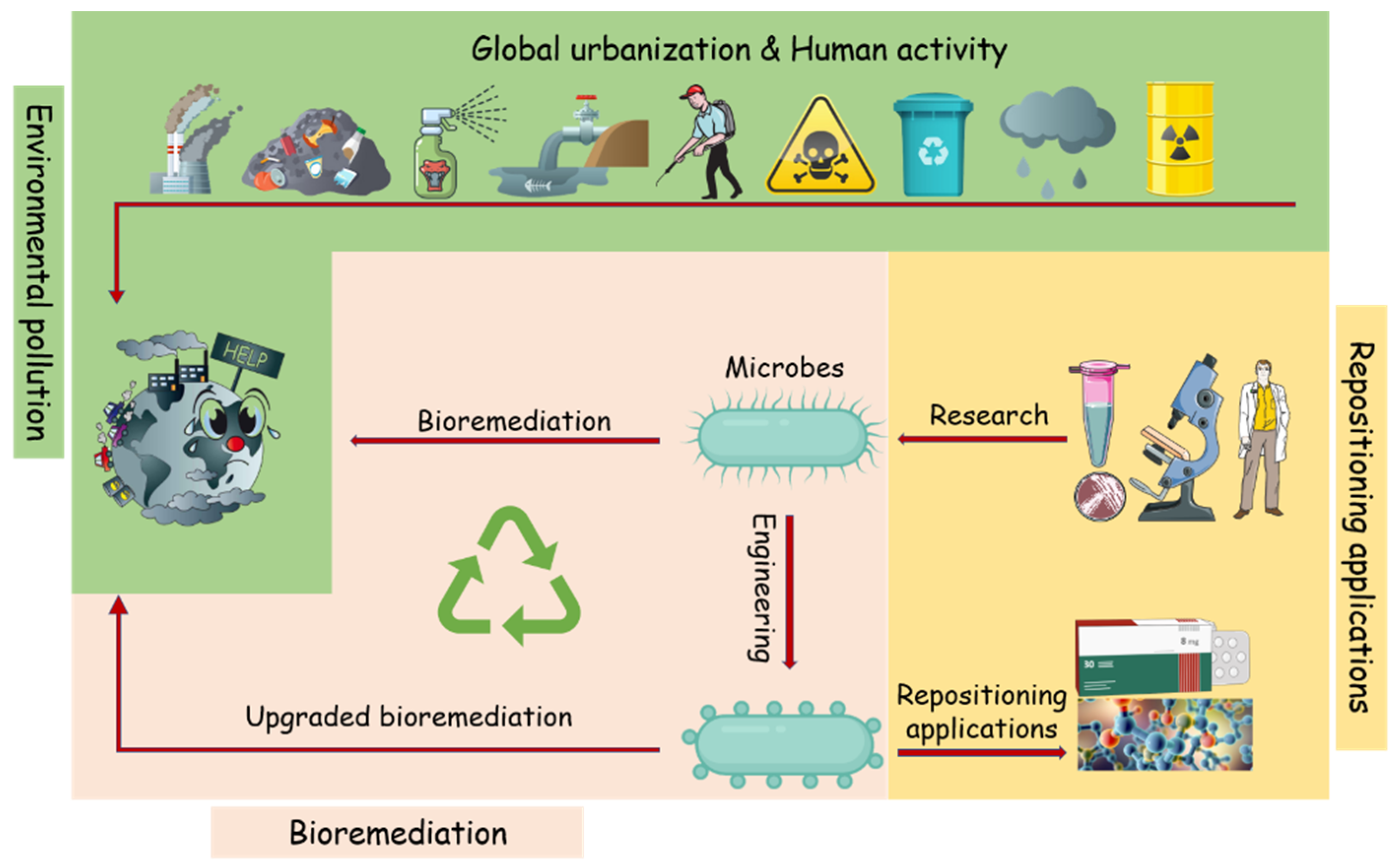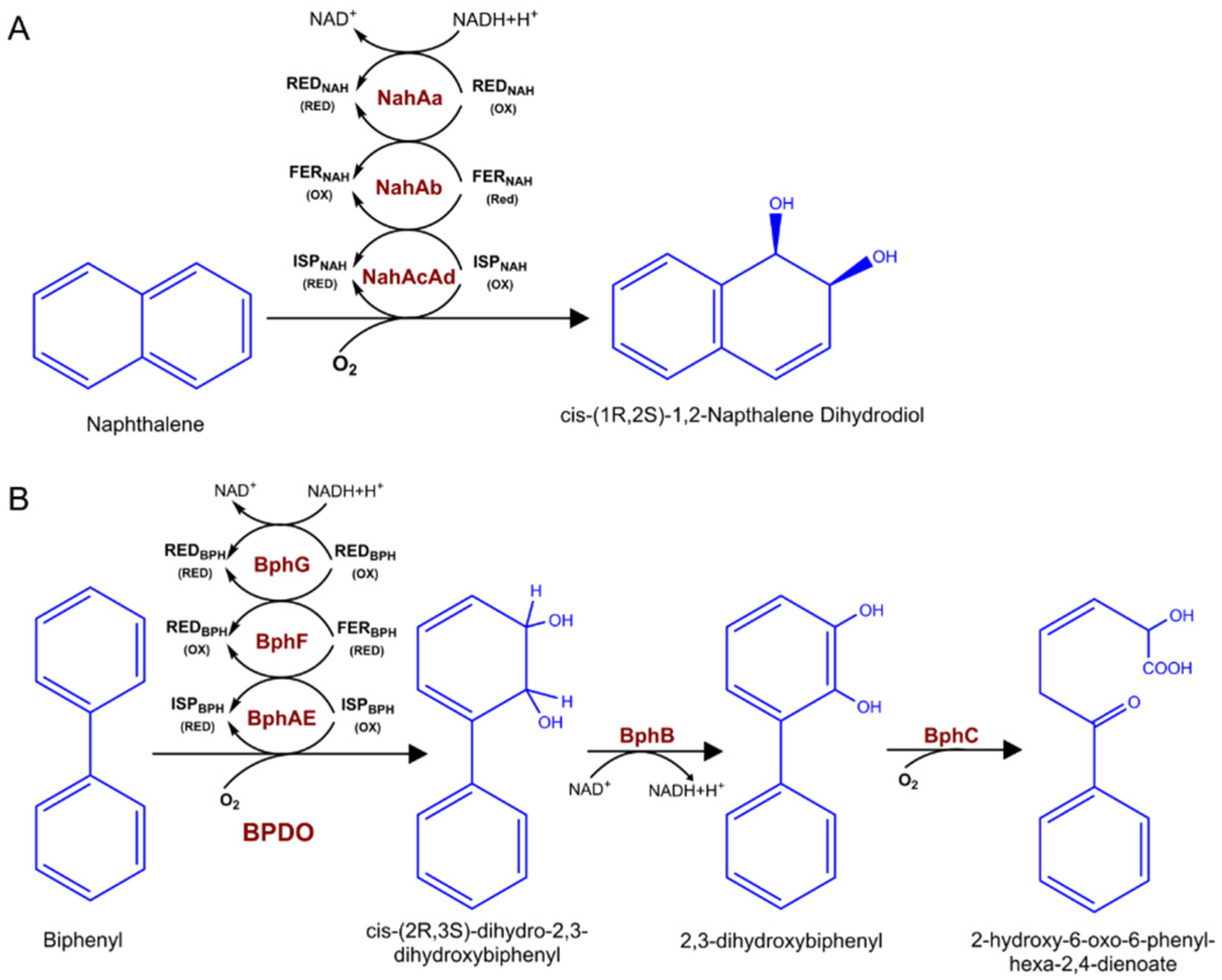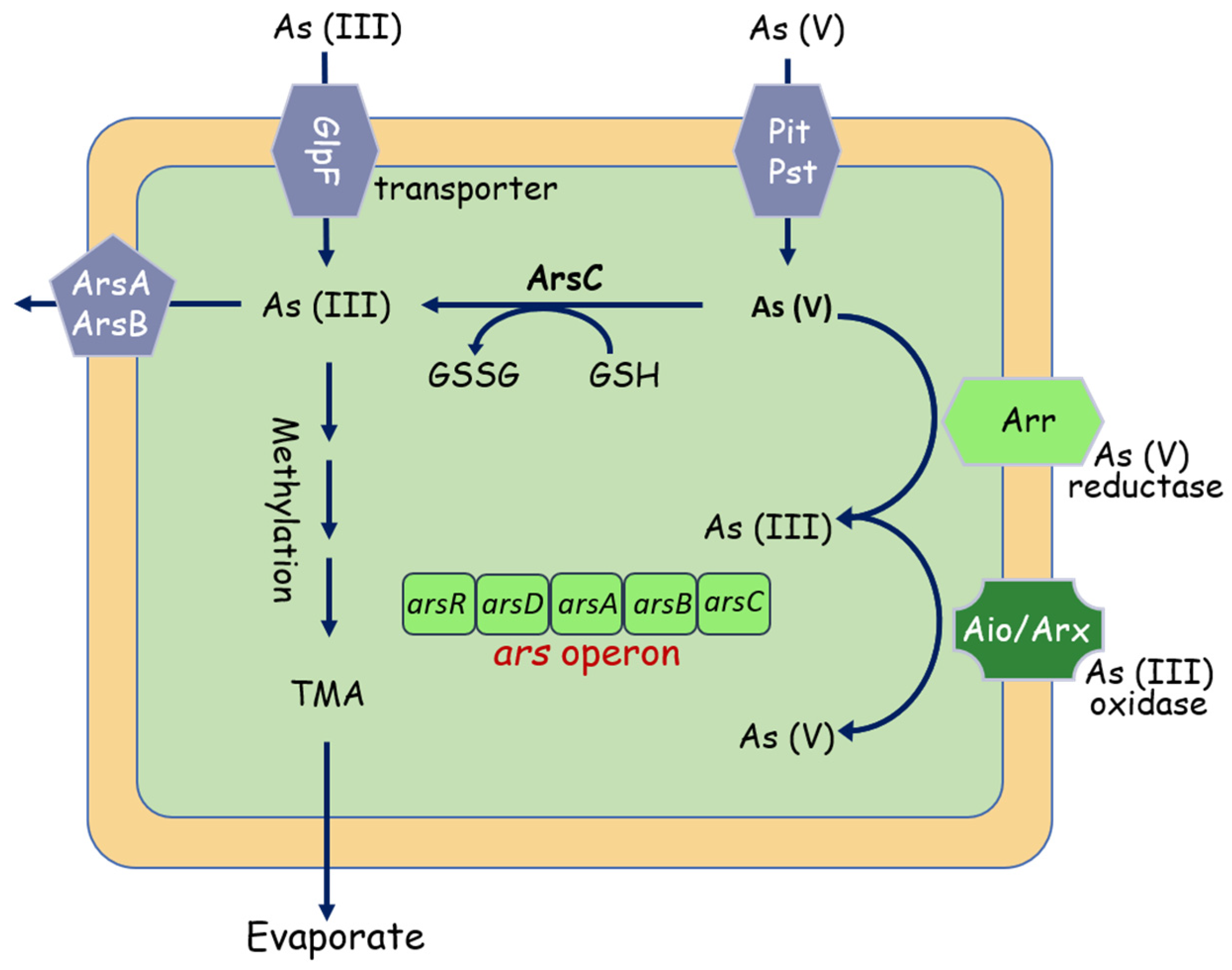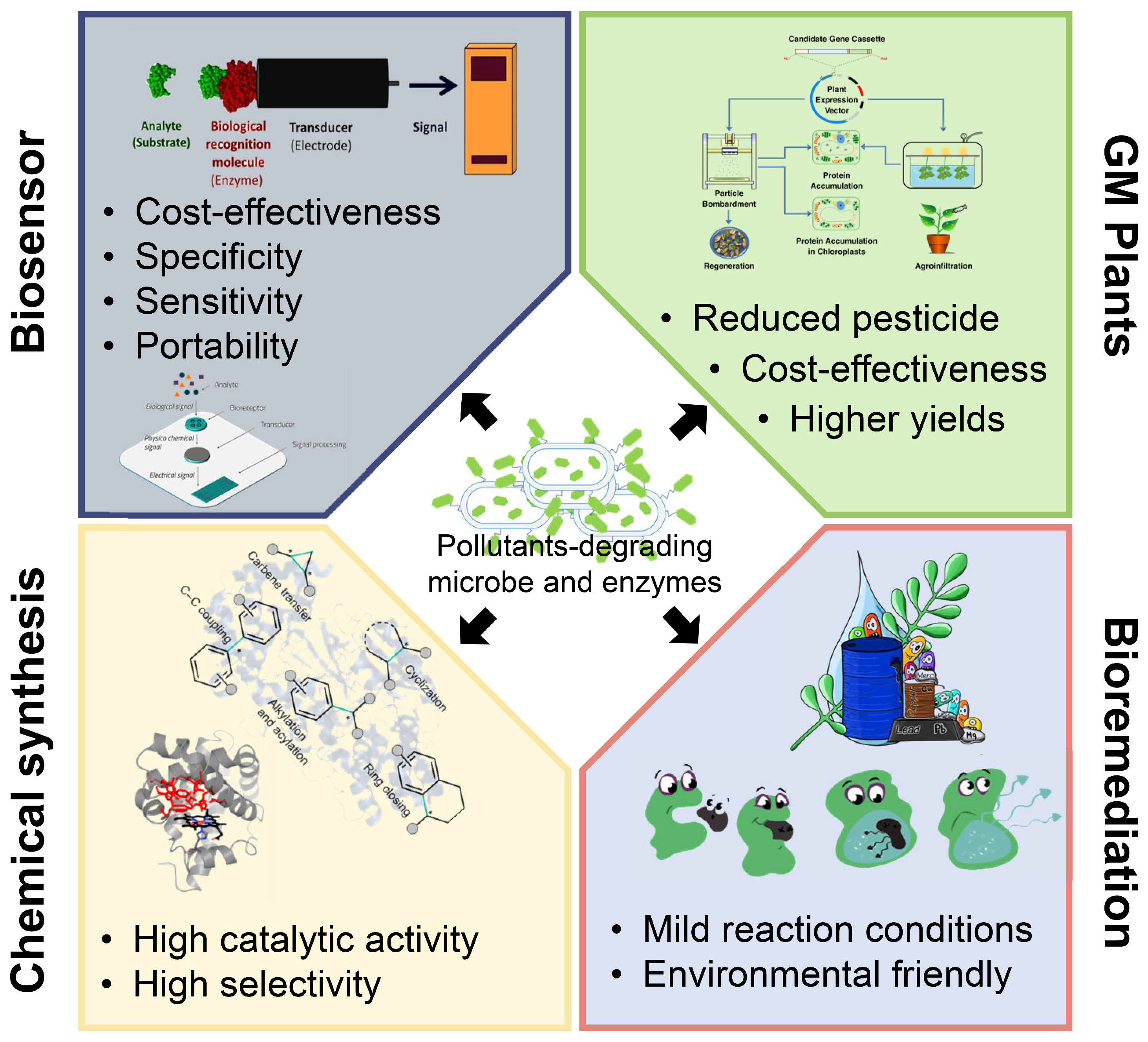Pollutant Degrading Enzyme: Catalytic Mechanisms and Their Expanded Applications
Abstract
1. Introduction
2. Enzymes Involved in Organic Pollutant Degradation and Transformation
2.1. Oxygenases in Degradation of Aromatic Compounds
2.2. Laccases Involved in the Ring Cleavage of Aromatic Compounds
2.3. Hydrolytic Lipases/Esterases Involved in Bioremediation
2.4. Heavy Metal Transforming Enzymes
3. Expanded Application of the Pollutant-Degrading Enzymes in Industries
3.1. Application of the Pollutant-Degrading Enzymes in Biosensors
3.2. Application of Pollutant-Degrading Enzymes in the Syntheses of Pharmaceutical Precursors
3.3. Application of Pollutant-Degrading Enzymes in the Biocatalysts of Chemical Products
| Microorganism | Enzyme Activity | Relevant Industrial Synthons | Reference |
|---|---|---|---|
| Sphingobium yanoikuyae B1 | Rieske oxygenase (RO) | cis-dihydrodiols | [83] |
| Burkholderia cepacia G4 | Toluene ortho-monooxygenase (TOM) | isoindigo indigo, indirubin, and isatin | [84] |
| Pseudomonas putida UV4 | Toluene dioxygenase (TDO) | 2,3-cis-dihydrodiol Toluene Chlorobenzene Bromobenzene Naphthalene | [85] |
| Escherichia coli BW25113 | TDO | 1,2-cis-dihydrocatechol | [86] |
| Sphingomonas sp. CHY-1 | Naphthalene dioxygenase (NDO) | Naphthalene | [87] |
| Pseudomonas sp. NCIB 9816–4 | NDO | (R)-1,2-phenylethanediol | [88] |
| Pseudomonas sp. species | Dihydrocatechol dehydrogenase (DHCD) | 2,3-Substituted catechols | [89] |
| Pseudomonas mendocina KR1 | Toluene-4-monooxygenase (T4MO) | 4-Substituted Phenol 3,4-Substituted Catechol | [90] |
| Pseudomonas putida S12 | TOM-Green | 1-Naphthol | [91] |
| Escherichia coli TG1 | Toluene-4-monooxygenase (T4MO) | Phenol 2-Naphthol | [92] |
| Pseudomonas putida S12 | Styrene monooxygenase (SMO) | Styrene oxide | [93] |
| Pseudomonas putida KT2440 | SMO | Epoxide | [94] |
| Rhodococcus sp. DK17 | o-xylene dioxygenase | 3-methylbenzylalcohol and 2,4-dimethylphenol | [95] |
| Pseudomonas putida KT2440 | ω-transaminases | 2-hydroxy ketone | [96] |
4. Conclusions and Perspectives
Author Contributions
Funding
Institutional Review Board Statement
Informed Consent Statement
Data Availability Statement
Conflicts of Interest
References
- Xu, X.; Nie, S.; Ding, H.; Hou, F.F. Environmental pollution and kidney diseases. Nat. Rev. Nephrol. 2018, 14, 313–324. [Google Scholar] [CrossRef]
- Claus, S.P.; Guillou, H.; Ellero-Simatos, S. The gut microbiota: A major player in the toxicity of environmental pollutants? NPJ Biofilms Microbiomes 2016, 2, 16003. [Google Scholar] [CrossRef] [PubMed]
- Rhind, S.M. Anthropogenic pollutants—An insidious threat to animal health and productivity? Acta Vet. Scand. 2012, 54, S2. [Google Scholar] [CrossRef]
- Allchin, C.R.; Law, R.J.; Morris, S. Polybrominated diphenylethers in sediments and biota downstream of potential sources in the uk. Environ. Pollut. 1999, 105, 197–207. [Google Scholar] [CrossRef]
- Martin, M.; Lam, P.K.S.; Richardson, B.J. An asian quandary: Where have all of the pbdes gone? Mar. Pollut. Bull. 2004, 49, 375–382. [Google Scholar] [CrossRef]
- Scheringer, M.; Stroebe, M.; Wania, F.; Wegmann, F.; Hungerbühler, K. The effect of export to the deep sea on the long-range transport potential of persistent organic pollutants. Environ. Sci Pollut. R 2004, 11, 41. [Google Scholar] [CrossRef][Green Version]
- Wu, M.; Li, W.; Dick, W.A.; Ye, X.; Chen, K.; Kost, D.; Chen, L. Bioremediation of hydrocarbon degradation in a petroleum-contaminated soil and microbial population and activity determination. Chemosphere 2017, 169, 124–130. [Google Scholar] [CrossRef] [PubMed]
- Dvorak, P.; Nikel, P.I.; Damborsky, J.; de Lorenzo, V. Bioremediation 3.0: Engineering pollutant-removing bacteria in the times of systemic biology. Biotechnol. Adv. 2017, 35, 845–866. [Google Scholar] [CrossRef]
- Han, H.P.; Vila-Aiub, M.M.; Jalaludin, A.; Yu, Q.; Powles, S.B. A double epsps gene mutation endowing glyphosate resistance shows a remarkably high resistance cost. Plant Cell Environ. 2017, 40, 3031–3042. [Google Scholar] [CrossRef]
- Takano, H.K.; Fernandes, V.N.A.; Adegas, F.S.; Oliveira, R.S.; Westra, P.; Gaines, T.A.; Dayan, F.E. A novel tipt double mutation in epsps conferring glyphosate resistance in tetraploid bidens subalternans. Pest Manag. Sci. 2020, 76, 95–102. [Google Scholar] [CrossRef]
- Gibson, D.T.; Parales, R.E. Aromatic hydrocarbon dioxygenases in environmental biotechnology. Curr. Opin. Biotechnol. 2000, 11, 236–243. [Google Scholar] [CrossRef]
- Nie, Y.; Chi, C.Q.; Fang, H.; Liang, J.L.; Lu, S.L.; Lai, G.L.; Tang, Y.Q.; Wu, X.L. Diverse alkane hydroxylase genes in microorganisms and environments. Sci. Rep. 2014, 4, 4968. [Google Scholar] [CrossRef]
- Wentzel, A.; Ellingsen, T.E.; Kotlar, H.K.; Zotchev, S.B.; Throne-Holst, M. Bacterial metabolism of long-chain n-alkanes. Appl. Microbiol. Biotechnol. 2007, 76, 1209–1221. [Google Scholar] [CrossRef]
- Wang, W.; Shao, Z. Diversity of flavin-binding monooxygenase genes (alma) in marine bacteria capable of degradation long-chain alkanes. FEMS Microbiol. Ecol. 2012, 80, 523–533. [Google Scholar] [CrossRef] [PubMed]
- van Beilen, J.B.; Funhoff, E.G.; van Loon, A.; Just, A.; Kaysser, L.; Bouza, M.; Holtackers, R.; Rothlisberger, M.; Li, Z.; Witholt, B. Cytochrome p450 alkane hydroxylases of the cyp153 family are common in alkane-degrading eubacteria lacking integral membrane alkane hydroxylases. Appl. Environ. Microbiol. 2006, 72, 59–65. [Google Scholar] [CrossRef]
- Nie, Y.; Fang, H.; Li, Y.; Chi, C.Q.; Tang, Y.Q.; Wu, X.L. The genome of the moderate halophile amycolicicoccus subflavus dqs3-9a1(t) reveals four alkane hydroxylation systems and provides some clues on the genetic basis for its adaptation to a petroleum environment. PLoS ONE 2013, 8, e70986. [Google Scholar] [CrossRef]
- Xu, A.; Wang, D.; Ding, Y.; Zheng, Y.; Wang, B.; Wei, Q.; Wang, S.; Yang, L.; Ma, L.Z. Integrated comparative genomic analysis and phenotypic profiling of pseudomonas aeruginosa isolates from crude oil. Front. Microbiol. 2020, 11, 519. [Google Scholar] [CrossRef]
- Loss, E.M.O.; Lee, M.K.; Wu, M.Y.; Martien, J.; Chen, W.P.; Amador-Noguez, D.; Jefcoate, C.; Remucal, C.; Jung, S.; Kim, S.C.; et al. Cytochrome p450 monooxygenase-mediated metabolic utilization of benzo[a]pyrene by aspergillus species. mBio 2019, 10, e00558-19. [Google Scholar]
- Zhang, J.J.; Liu, H.; Xiao, Y.; Zhang, X.E.; Zhou, N.Y. Identification and characterization of catabolic para-nitrophenol 4-monooxygenase and para-benzoquinone reductase from Pseudomonas sp. Strain wbc-3. J. Bacteriol. 2009, 191, 2703–2710. [Google Scholar] [CrossRef] [PubMed]
- Yang, Y.; Wang, J.; Liao, J.; Xie, S.; Huang, Y. Distribution of naphthalene dioxygenase genes in crude oil-contaminated soils. Microb. Ecol. 2014, 68, 785–793. [Google Scholar] [CrossRef] [PubMed]
- Kumari, S.; Mangwani, N.; Das, S. Naphthalene catabolism by biofilm forming marine bacterium pseudomonas aeruginosa n6p6 and the role of quorum sensing in regulation of dioxygenase gene. J. Appl. Microbiol. 2021, 130, 1217–1231. [Google Scholar] [CrossRef]
- Parales, R.E.; Resnick, S.M.; Yu, C.L.; Boyd, D.R.; Sharma, N.D.; Gibson, D.T. Regioselectivity and enantioselectivity of naphthalene dioxygenase during arene cis-dihydroxylation: Control by phenylalanine 352 in the alpha subunit. J. Bacteriol. 2000, 182, 5495–5504. [Google Scholar] [CrossRef]
- Furukawa, K.; Suenaga, H.; Goto, M. Biphenyl dioxygenases: Functional versatilities and directed evolution. J. Bacteriol. 2004, 186, 5189–5196. [Google Scholar] [CrossRef]
- Suenaga, H.; Fujihara, H.; Kimura, N.; Hirose, J.; Watanabe, T.; Futagami, T.; Goto, M.; Shimodaira, J.; Furukawa, K. Insights into the genomic plasticity of pseudomonas putida kf715, a strain with unique biphenyl-utilizing activity and genome instability properties. Environ. Microbiol. Rep. 2017, 9, 589–598. [Google Scholar] [CrossRef] [PubMed]
- Garrido-Sanz, D.; Sansegundo-Lobato, P.; Redondo-Nieto, M.; Suman, J.; Cajthaml, T.; Blanco-Romero, E.; Martin, M.; Uhlik, O.; Rivilla, R. Analysis of the biodegradative and adaptive potential of the novel polychlorinated biphenyl degrader Rhodococcus sp. Way2 revealed by its complete genome sequence. Microb. Genom. 2020, 6, mgen000363. [Google Scholar] [CrossRef] [PubMed]
- Shekher, R.; Sehgal, S.; Kamthania, M.; Kumar, A. Laccase: Microbial sources, production, purification, and potential biotechnological applications. Enzym. Res. 2011, 2011, 1–11. [Google Scholar]
- Zeng, J.; Zhu, Q.H.; Wu, Y.C.; Lin, X.G. Oxidation of polycyclic aromatic hydrocarbons using bacillus subtilis cota with high laccase activity and copper independence. Chemosphere 2016, 148, 1–7. [Google Scholar] [CrossRef]
- Hu, X.K.; Zhao, X.H.; Hwang, H.M. Comparative study of immobilized trametes versicolor laccase on nanoparticles and kaolinite. Chemosphere 2007, 66, 1618–1626. [Google Scholar] [CrossRef] [PubMed]
- Canas, A.I.; Alcalde, M.; Plou, F.; Martinez, M.J.; Martinez, A.T.; Camarero, S. Transformation of polycyclic aromatic hydrocarbons by laccase is strongly enhanced by phenolic compounds present in soil. Environ. Sci. Technol. 2007, 41, 2964–2971. [Google Scholar] [CrossRef]
- Hou, Y.; Tao, J.; Shen, W.; Liu, J.; Li, J.; Li, Y.; Cao, H.; Cui, Z. Isolation of the fenoxaprop-ethyl (fe)-degrading bacterium Rhodococcus sp. T1, and cloning of fe hydrolase gene feh. FEMS Microbiol. Lett. 2011, 323, 196–203. [Google Scholar] [CrossRef]
- Nie, Z.J.; Hang, B.J.; Cai, S.; Xie, X.T.; He, J.; Shunpeng, L. Degradation of cyhalofop-butyl (cyb) by pseudomonas azotoformans strain qdz-1, and cloning of a novel gene encoding cyb-hydrolyzing esterase. J. Agric. Food Chem. 2011, 59, 6040–6046. [Google Scholar] [CrossRef]
- Zhang, J.; Yin, J.-G.; Hang, B.-J.; Cai, S.; He, J.; Zhou, S.-G.; Li, S.-P. Cloning of a novel arylamidase gene from Paracoccus sp. Strain fln-7 that hydrolyzes amide pesticides. Appl. Environ. Microbiol. 2012, 78, 4848–4855. [Google Scholar] [CrossRef]
- Wang, B.Z.; Guo, P.; Hang, B.J.; Li, L.; He, J.; Li, S.P. Cloning of a novel pyrethroid-hydrolyzing carboxylesterase gene from Sphingobium sp. Strain jz-1 and characterization of the gene product. Appl. Environ. Microbiol. 2009, 75, 5496–5500. [Google Scholar] [CrossRef]
- Li, G.; Wang, K.; Liu, Y.H. Molecular cloning and characterization of a novel pyrethroid-hydrolyzing esterase originating from the metagenome. Microb. Cell Factories 2008, 7, 38. [Google Scholar] [CrossRef] [PubMed]
- Fan, X.; Liu, X.; Huang, R.; Liu, Y. Identification and characterization of a novel thermostable pyrethroid-hydrolyzing enzyme isolated through metagenomic approach. Microb. Cell Factories 2012, 11, 33. [Google Scholar] [CrossRef] [PubMed]
- Liu, X.L.; Liang, M.J.; Liu, Y.H.; Fan, X.J. Directed evolution and secretory expression of a pyrethroid-hydrolyzing esterase with enhanced catalytic activity and thermostability. Microb. Cell Factories 2017, 16, 1–12. [Google Scholar] [CrossRef]
- Kawahara, K.; Tanaka, A.; Yoon, J.; Yokota, A. Reclassification of a parathione-degrading Flavobacterium sp. atcc 27551 as sphingobium fuliginis. J. Gen. Appl. Microbiol. 2010, 56, 249–255. [Google Scholar] [CrossRef]
- Verma, S.; Kuila, A. Bioremediation of heavy metals by microbial process. Environ. Technol. Innov. 2019, 14, 100369. [Google Scholar] [CrossRef]
- Barkay, T.; Turner, R.R.; Vandenbrook, A.; Liebert, C. The relationships of hg(ii) volatilization from a fresh-water pond to the abundance of mer-genes in the gene pool of the indigenous microbial community. Microb. Ecol. 1991, 21, 151–161. [Google Scholar] [CrossRef] [PubMed]
- Barkay, T.; Wagner-Dobler, I. Microbial transformations of mercury: Potentials, challenges, and achievements in controlling mercury toxicity in the environment. Adv. Appl. Microbiol. 2005, 57, 1–52. [Google Scholar] [PubMed]
- Lu, X.; Liu, Y.R.; Johs, A.; Zhao, L.D.; Wang, T.S.; Yang, Z.M.; Lin, H.; Elias, D.A.; Pierce, E.M.; Liang, L.Y.; et al. Anaerobic mercury methylation and demethylation by geobacter bemidjiensis bem. Environ. Sci. Technol. 2016, 50, 4366–4373. [Google Scholar] [CrossRef]
- Lu, X.; Gu, W.Y.; Zhao, L.D.; Farhan Ul Haque, M.; DiSpirito, A.A.; Semrau, J.D.; Gu, B.H. Methylmercury uptake and degradation by methanotrophs. Sci. Adv. 2017, 3, e1700041. [Google Scholar] [CrossRef] [PubMed]
- Borremans, B.; Hobman, J.; Provoost, A.; Brown, N.; van Der Lelie, D. Cloning and functional analysis of thepbr lead resistance determinant of ralstonia metallidurans ch34. J. Bacteriol. 2001, 183, 5651–5658. [Google Scholar] [CrossRef] [PubMed]
- Hobman, J.L.; Julian, D.J.; Brown, N.L.J.B.M. Cysteine coordination of pb (ii) is involved in the pbrr-dependent activation of the lead-resistance promoter, ppbra, from cupriavidus metallidurans ch34. BMC Microbiol. 2012, 12, 109. [Google Scholar] [CrossRef] [PubMed]
- Hynninen, A.; Touzé, T.; Pitkänen, L.; Mengin-Lecreulx, D.; Virta, M. An efflux transporter pbra and a phosphatase pbrb cooperate in a lead-resistance mechanism in bacteria. Mol. Microbiol. 2009, 74, 384–394. [Google Scholar] [CrossRef]
- Naik, M.M.; Shamim, K.; Dubey, S.K. Biological characterization of lead-resistant bacteria to explore role of bacterial metallothionein in lead resistance. Curr. Sci. India 2012, 103, 426–429. [Google Scholar]
- Naik, M.M.; Pandey, A.; Dubey, S.K. Pseudomonas aeruginosa strain wi-1 from mandovi estuary possesses metallothionein to alleviate lead toxicity and promotes plant growth. Ecotox. Environ. Safe 2012, 79, 129–133. [Google Scholar] [CrossRef]
- Sharma, J.; Shamim, K.; Dubey, S.K.; Meena, R.M. Metallothionein assisted periplasmic lead sequestration as lead sulfite by providencia vermicola strain sj2a. Sci. Total Environ. 2017, 579, 359–365. [Google Scholar] [CrossRef]
- Deng, F.L.; Liu, X.; Chen, Y.S.; Rathinasabapathi, B.; Rensing, C.; Chen, J.; Bi, J.; Xian, P.; Ma, L.N.Q. Aquaporins mediated arsenite transport in plants: Molecular mechanisms and applications in crop improvement. Crit. Rev. Environ. Sci. Technol. 2020, 50, 1613–1639. [Google Scholar] [CrossRef]
- Li, J.; Li, C.; Sun, H.J.; Juhasz, A.L.; Luo, J.; Li, H.B.; Ma, L.Q. Arsenic relative bioavailability in contaminated soils: Comparison of animal models, dosing schemes, and biological end points. Environ. Sci Technol. 2016, 50, 453–461. [Google Scholar] [CrossRef]
- Wang, X.; Rathinasabapathi, B.; de Oliveira, L.M.; Guilherme, L.R.G.; Ma, L.N.Q. Bacteria-mediated arsenic oxidation and reduction in the growth media of arsenic hyperaccumulator pteris vittata. Environ. Sci. Technol. 2012, 46, 11259–11266. [Google Scholar] [CrossRef]
- Andres, J.; Bertin, P.N. The microbial genomics of arsenic. FEMS Microbiol. Rev. 2016, 40, 299–322. [Google Scholar] [CrossRef] [PubMed]
- Martin, P.; DeMel, S.; Shi, J.; Gladysheva, T.; Gatti, D.L.; Rosen, B.P.; Edwards, B.F.P. Insights into the structure, solvation, and mechanism of arsc arsenate reductase, a novel arsenic detoxification enzyme. Structure 2001, 9, 1071–1081. [Google Scholar] [CrossRef]
- Kruger, M.C.; Bertin, P.N.; Heipieper, H.J.; Arsene-Ploetze, F. Bacterial metabolism of environmental arsenic-mechanisms and biotechnological applications. Appl. Microbiol. Biotechnol. 2013, 97, 3827–3841. [Google Scholar] [CrossRef] [PubMed]
- Han, Y.H.; Yin, D.X.; Jia, M.R.; Wang, S.S.; Chen, Y.S.; Rathinasabapathi, B.; Chen, D.L.; Ma, L.Q. Arsenic-resistance mechanisms in bacterium leclercia adecarboxylata strain as3-1: Biochemical and genomic analyses. Sci. Total Environ. 2019, 690, 1178–1189. [Google Scholar] [CrossRef]
- Stolz, J.E.; Basu, P.; Santini, J.M.; Oremland, R.S. Arsenic and selenium in microbial metabolism. Annu. Rev. Microbiol. 2006, 60, 107–130. [Google Scholar] [CrossRef] [PubMed]
- Silver, S.; Phung, L.T. Genes and enzymes involved in bacterial oxidation and reduction of inorganic arsenic. Appl. Environ. Microbiol. 2005, 71, 599–608. [Google Scholar] [CrossRef] [PubMed]
- Lett, M.C.; Muller, D.; Lievremont, D.; Silver, S.; Santini, J. Unified nomenclature for genes involved in prokaryotic aerobic arsenite oxidation. J. Bacteriol. 2012, 194, 207–208. [Google Scholar] [CrossRef]
- Neethirajan, S.; Ragavan, V.; Weng, X.; Chand, R. Biosensors for sustainable food engineering: Challenges and perspectives. Biosensors 2018, 8, 23. [Google Scholar] [CrossRef]
- Wang, X.; Lu, X.B.; Chen, J.P. Development of biosensor technologies for analysis of environmental contaminants. Trends Environ. Anal. 2014, 2, 25–32. [Google Scholar] [CrossRef]
- Nguyen, H.H.; Lee, S.H.; Lee, U.J.; Fermin, C.D.; Kim, M. Immobilized enzymes in biosensor applications. Materials 2019, 12, 121. [Google Scholar] [CrossRef]
- Stoytcheva, M.; Zlatev, R.; Velkova, Z.; Valdez, B. Organophosphorus Pesticides Determination by Electrochemical Biosensors; InTech: Rijeka, Croatia, 2011; pp. 359–372. [Google Scholar]
- Pundir, C.S.; Chauhan, N. Acetylcholinesterase inhibition-based biosensors for pesticide determination: A review. Anal. Biochem. 2012, 429, 19–31. [Google Scholar] [CrossRef] [PubMed]
- Karami, R.; Mohsenifar, A.; Namini, S.M.M.; Kamelipour, N.; Rahmani-Cherati, T.; Shojaei, T.R.; Tabatabaei, M. A novel nanobiosensor for the detection of paraoxon using chitosan-embedded organophosphorus hydrolase immobilized on au nanoparticles. Prep. Biochem. Biotech. 2016, 46, 559–566. [Google Scholar] [CrossRef]
- Jain, M.; Yadav, P.; Joshi, B.; Joshi, A.; Kodgire, P. A novel biosensor for the detection of organophosphorus (op)-based pesticides using organophosphorus acid anhydrolase (opaa)-fl variant. Appl. Microbiol. Biotechnol. 2021, 105, 389–400. [Google Scholar] [CrossRef] [PubMed]
- Kumar, J.; Jha, S.K.; D’Souza, S.F. Optical microbial biosensor for detection of methyl parathion pesticide using Flavobacterium sp. whole cells adsorbed on glass fiber filters as disposable biocomponent. Biosens. Bioelectron. 2006, 21, 2100–2105. [Google Scholar] [CrossRef] [PubMed]
- Gavlasova, P.; Kuncova, G.; Kochankova, L.; Mackova, M. Whole cell biosensor for polychlorinated biphenyl analysis based on optical detection. Int. Biodeterior. Biodegrad. 2008, 62, 304–312. [Google Scholar] [CrossRef]
- Sacks, V.; Eshkenazi, I.; Neufeld, T.; Dosoretz, C.; Rishpon, J. Immobilized parathion hydrolase: An amperometric sensor for parathion. Anal. Chem. 2000, 72, 2055–2058. [Google Scholar] [CrossRef]
- Arnold, F.H. Combinatorial and computational challenges for biocatalyst design. Nature 2001, 409, 253–257. [Google Scholar] [CrossRef]
- Lobastova, T.G.; Sukhodolskaya, G.V.; Nikolayeva, V.M.; Baskunov, B.P.; Turchin, K.F.; Donova, M.V. Hydroxylation of carbazoles by aspergillus flavus vkm f-1024. FEMS Microbiol. Lett. 2004, 235, 51–56. [Google Scholar] [CrossRef][Green Version]
- Resnick, S.M.; Torok, D.S.; Gibson, D.T. Oxidation of carbazole to 3-hydroxycarbazole by naphthalene 1,2-dioxygenase and biphenyl 2,3-dioxygenase. FEMS Microbiol. Lett. 1993, 113, 297–302. [Google Scholar] [CrossRef]
- Schmid, A.; Dordick, J.S.; Hauer, B.; Kiener, A.; Wubbolts, M.; Witholt, B. Industrial biocatalysis today and tomorrow. Nature 2001, 409, 258–268. [Google Scholar] [CrossRef]
- Wang, S.N.; Xu, P.; Tang, H.Z.; Meng, J.; Liu, X.L.; Ma, C.Q. “Green” route to 6-hydroxy-3-succinoyl-pyridine from (s)-nicotine of tobacco waste by whole cells of a Pseudomonas sp. Environ. Sci. Technol. 2005, 39, 6877–6880. [Google Scholar] [CrossRef]
- Tang, H.Z.; Yao, Y.X.; Zhang, D.K.; Meng, X.Z.; Wang, L.J.; Yu, H.; Ma, L.Y.; Xu, P. A novel nadh-dependent and fad-containing hydroxylase is crucial for nicotine degradation by pseudomonas putida. J. Biol. Chem. 2011, 286, 39179–39187. [Google Scholar] [CrossRef] [PubMed]
- Yu, H.; Tang, H.Z.; Xu, P. Green strategy from waste to value-added-chemical production: Efficient biosynthesis of 6-hydroxy-3-succinoyl-pyridine by an engineered biocatalyst. Sci. Rep. 2014, 4, 5397. [Google Scholar] [CrossRef] [PubMed]
- Hu, H.Y.; Wang, L.J.; Wang, W.W.; Wu, G.; Tao, F.; Xu, P.; Deng, Z.X.; Tang, H.Z. Regulatory mechanism of nicotine degradation in pseudomonas putida. mBio 2019, 10, e00602-19. [Google Scholar] [CrossRef] [PubMed]
- Ballard, D.G.H.; Courtis, A.; Shirley, I.M.; Taylor, S.C. A biotech route to polyphenylene. J. Chem. Soc. Chem. Comm. 1983, 17, 954–955. [Google Scholar] [CrossRef]
- Rogers, M.S.; Lipscomb, J.D. Salicylate 5-hydroxylase: Intermediates in aromatic hydroxylation by a rieske monooxygenase. Biochemistry 2019, 58, 5305–5319. [Google Scholar] [CrossRef] [PubMed]
- Wackett, L.P. Mechanism and applications of rieske non-heme iron dioxygenases. Enzym. Microb. Tech. 2002, 31, 577–587. [Google Scholar] [CrossRef]
- Boyd, D.R.; Bugg, T.D.H. Arene cis-dihydrodiol formation: From biology to application. Org. Biomol. Chem. 2006, 4, 181–192. [Google Scholar] [CrossRef]
- Boyd, D.R.; Sharma, N.D.; Coen, G.P.; Gray, P.J.; Malone, J.F.; Gawronski, J. Enzyme-catalysed synthesis and absolute configuration assignments of cis-dihydrodiol metabolites from 1,4-disubstituted benzenes. Chem. Eur. J. 2007, 13, 5804–5811. [Google Scholar] [CrossRef]
- Zhang, X.W.; Qu, Y.Y.; Ma, Q.; Zhou, H.; Li, X.L.; Kong, C.L.; Zhou, J.T. Cloning and expression of naphthalene dioxygenase genes from Comamonas sp. mq for indigoids production. Process. Biochem. 2013, 48, 581–587. [Google Scholar] [CrossRef]
- Ferraro, D.J.; Brown, E.N.; Yu, C.L.; Parales, R.E.; Gibson, D.T.; Ramaswamy, S. Structural investigations of the ferredoxin and terminal oxygenase components of the biphenyl 2,3-dioxygenase from sphingobium yanoikuyae b1. BMC Struct. Biol. 2007, 7, 10. [Google Scholar] [CrossRef] [PubMed]
- Rui, L.Y.; Reardon, K.F.; Wood, T.K. Protein engineering of toluene ortho-monooxygenase of burkholderia cepacia g4 for regiospecific hydroxylation of indole to form various indigoid compounds. Appl. Microbiol. Biotechnol. 2005, 66, 422–429. [Google Scholar] [CrossRef] [PubMed]
- Boyd, D.R.; Sharma, N.D.; Bowers, N.I.; Dalton, H.; Garrett, M.D.; Harrison, J.S.; Sheldrake, G.N. Dioxygenase-catalysed oxidation of disubstituted benzene substrates: Benzylic monohydroxylation versus aryl cis-dihydroxylation and the meta effect. Org. Biomol. Chem. 2006, 4, 3343–3349. [Google Scholar] [CrossRef] [PubMed]
- Wissner, J.L.; Ludwig, J.; Escobedo-Hinojosa, W.; Hauer, B. An enhanced toluene dioxygenase platform for the production of cis-1,2-dihydrocatechol in escherichia coli bw25113 lacking glycerol dehydrogenase activity. J. Biotechnol. 2021, 325, 380–388. [Google Scholar] [CrossRef] [PubMed]
- Jouanneau, Y.; Meyer, C.; Duraffourg, N. Dihydroxylation of four- and five-ring aromatic hydrocarbons by the naphthalene dioxygenase from sphingomonas chy-1. Appl. Microbiol. Biotechnol. 2016, 100, 1253–1263. [Google Scholar] [CrossRef]
- McKenna, R.; Pugh, S.; Thompson, B.; Nielsen, D.R. Microbial production of the aromatic building-blocks (s)-styrene oxide and (r)-1,2-phenylethanediol from renewable resources. Biotechnol. J. 2013, 8, 1465–1475. [Google Scholar] [CrossRef]
- Vasudevan, S.; Bhat, S.V. Biotransformation of isoeugenol catalyzed by growing cells of pseudomonas putida. Biocatal. Biotransfor. 2011, 29, 147–150. [Google Scholar] [CrossRef]
- Gullotto, A.; Branciamore, S.; Duchi, I.; Cano, M.F.P.; Randazzo, D.; Tilli, S.; Giardina, P.; Sannia, G.; Scozzafava, A.; Briganti, F. Combined action of a bacterial monooxygenase and a fungal laccase for the biodegradation of mono- and poly-aromatic hydrocarbons. Bioresour. Technol. 2008, 99, 8353–8359. [Google Scholar] [CrossRef] [PubMed]
- Garikipati, S.V.B.J.; Peeples, T.L. Solvent resistance pumps of pseudomonas putida s12: Applications in 1-naphthol production and biocatalyst engineering. J. Biotechnol. 2015, 210, 91–99. [Google Scholar] [CrossRef]
- Tao, Y.; Bentley, W.E.; Wood, T.K. Phenol and 2-naphthol production by toluene 4-monooxygenases using an aqueous/dioctyl phthalate system. Appl. Microbiol. Biotechnol. 2005, 68, 614–621. [Google Scholar] [CrossRef] [PubMed]
- Panke, S.; Held, M.; Wubbolts, M.G.; Witholt, B.; Schmid, A. Pilot-scale production of (s)-styrene oxide from styrene by recombinant escherichia coli synthesizing styrene monooxygenase. Biotechnol. Bioeng. 2002, 80, 33–41. [Google Scholar] [CrossRef] [PubMed]
- Tan, C.L.; Zhang, X.; Zhu, Z.J.; Xu, M.J.; Yang, T.W.; Osire, T.; Yang, S.T.; Rao, Z.M. Asp305gly mutation improved the activity and stability of the styrene monooxygenase for efficient epoxide production in pseudomonas putida kt2440. Microb. Cell Factories 2019, 18, 1–14. [Google Scholar] [CrossRef] [PubMed]
- Kim, D.; Choi, K.Y.; Yoo, M.; Choi, J.N.; Lee, C.H.; Zylstra, G.J.; Kang, B.S.; Kim, E. Benzylic and aryl hydroxylations of m-xylene by o-xylene dioxygenase from Rhodococcus sp. strain dk17. Appl. Microbiol. Biotechnol. 2010, 86, 1841–1847. [Google Scholar] [CrossRef] [PubMed]
- Sehl, T.; Simon, R.C.; Hailes, H.C.; Ward, J.M.; Schell, U.; Pohl, M.; Rother, D. Ttc-based screening assay for ω-transaminases: A rapid method to detect reduction of 2-hydroxy ketones. J. Biotechnol. 2012, 159, 188–194. [Google Scholar] [CrossRef]
- Lovley, D.R. Cleaning up with genomics: Applying molecular biology to bioremediation. Nat. Rev. Microbiol. 2003, 1, 35–44. [Google Scholar] [CrossRef]
- Planas-Iglesias, J.; Marques, S.M.; Pinto, G.P.; Musil, M.; Stourac, J.; Damborsky, J.; Bednar, D. Computational design of enzymes for biotechnological applications. Biotechnol. Adv. 2021, 47, 107696. [Google Scholar] [CrossRef] [PubMed]





Publisher’s Note: MDPI stays neutral with regard to jurisdictional claims in published maps and institutional affiliations. |
© 2021 by the authors. Licensee MDPI, Basel, Switzerland. This article is an open access article distributed under the terms and conditions of the Creative Commons Attribution (CC BY) license (https://creativecommons.org/licenses/by/4.0/).
Share and Cite
Xu, A.; Zhang, X.; Wu, S.; Xu, N.; Huang, Y.; Yan, X.; Zhou, J.; Cui, Z.; Dong, W. Pollutant Degrading Enzyme: Catalytic Mechanisms and Their Expanded Applications. Molecules 2021, 26, 4751. https://doi.org/10.3390/molecules26164751
Xu A, Zhang X, Wu S, Xu N, Huang Y, Yan X, Zhou J, Cui Z, Dong W. Pollutant Degrading Enzyme: Catalytic Mechanisms and Their Expanded Applications. Molecules. 2021; 26(16):4751. https://doi.org/10.3390/molecules26164751
Chicago/Turabian StyleXu, Anming, Xiaoxiao Zhang, Shilei Wu, Ning Xu, Yan Huang, Xin Yan, Jie Zhou, Zhongli Cui, and Weiliang Dong. 2021. "Pollutant Degrading Enzyme: Catalytic Mechanisms and Their Expanded Applications" Molecules 26, no. 16: 4751. https://doi.org/10.3390/molecules26164751
APA StyleXu, A., Zhang, X., Wu, S., Xu, N., Huang, Y., Yan, X., Zhou, J., Cui, Z., & Dong, W. (2021). Pollutant Degrading Enzyme: Catalytic Mechanisms and Their Expanded Applications. Molecules, 26(16), 4751. https://doi.org/10.3390/molecules26164751






